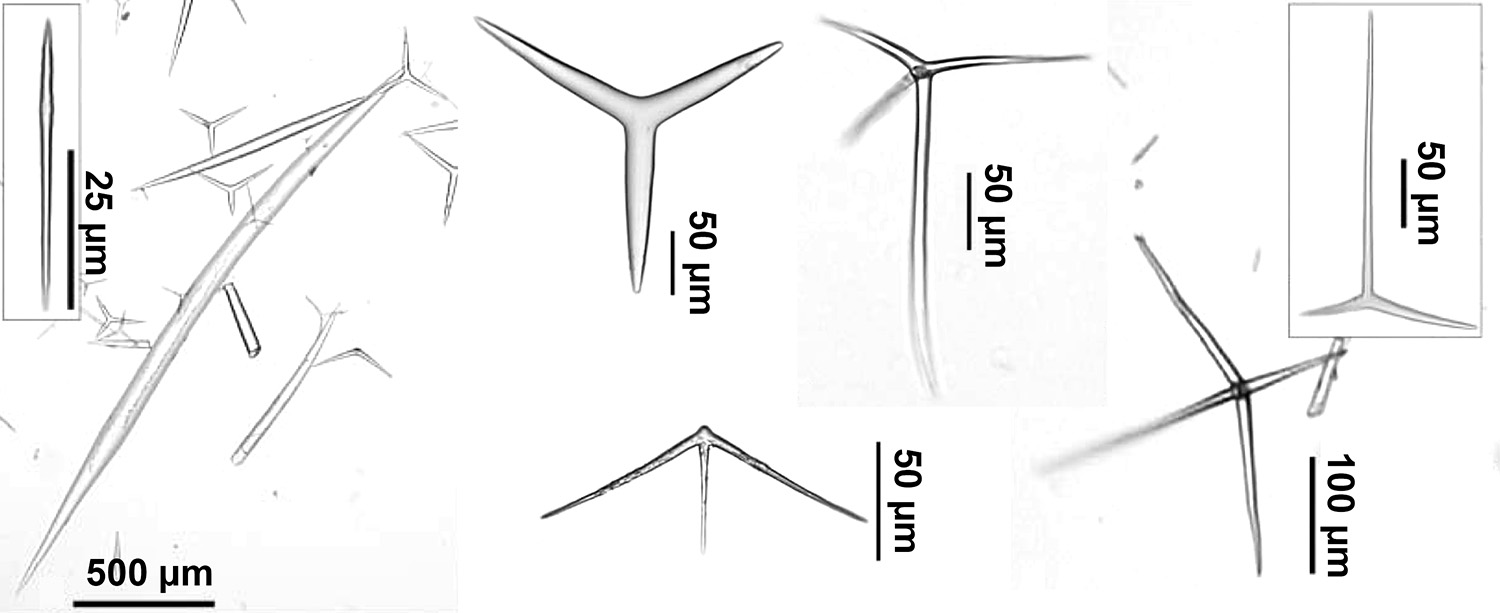Morphological description (show/hide)
| Bottle-like and bulbous, small, with a specimen size of 1.5x1 cm. | | white | | white | | One prominent central osculum with a tuft of long diactine. | | Harsh | | Hispid due to giant longitudinal diactines partially protruding through the surface. | | An articulated skeleton of t-shaped sagittal triactines supports walls of the syconoid choanocyte chambers, with their perpendicular longer unpaired actines pointing towards the cortex. Distinct subatrial canals on the exhalant side of each choanocyte chamber are present, devoid of choanocytes. Here, the skeleton is also supported by t-shaped triactines, like those in the choanosome, but is clearly characterized by additional stacked tripod-like tetractines with a reduced apical actine, with their reduced actine pointing towards the cortex. The distinct atrial skeleton is supported by large tetractines, with their basal triradiate system forming the atrial wall and their free curved actines protruding into the atrium. These free actines are curved in the direction of the osculum. The choanosome gradually thins out towards the osculum, and is completely reduced at the oscular fringe, which is supported only by tangential large diactines and in its distal part by thin, long diactines. These long, thin diactines are tangentially arranged around the inside of the fringe (with larger and thicker diactines at the external part). | | With a distinct cortex of longitudinally arranged large diactines and smaller tangential triactines. Perpendicularly arranged microdiactines partially protrude through the external surface. The cortex has a thickness of about 50 um and is followed by a thick subcortical area. Subdermal cavities of the inhalant canal system, with a diameter of up to 800_500 um, are located between the cortex and subcortical areas. The subcortical area has a maximum thickness of 2 mm and is supported by longitudinally aligned large diactines and irregularly intercalated smaller triactines, similar to those in the cortical area. The long and thick diactines do not protrude into the choanosome and are not arranged perpendicularly. Subcortical triactines have a slightly similar shape to pseudosagittal spicules, whereas one of the paired actines is slightly shorter. Sometimes the angle between the smaller paired actine and the unpaired actine faces towards the cortex, and the longer paired actine is perpendicular to the cortex, pointing towards the choanosome (atrium), somehow slightly resembling the position of pseudosagittal spicules in Heteropiidae. Inhalant cavities occur between the subcortex and choanosome, with a maximum diameter of 250 um. | | Large cortical/sub-cortical diactines have a thicker central part, tapering towards both ends: 227-(708.2)-1777_20-(47.7)-107 um (SD 342.6_25.3 um), Subcortical triactines slightly sagittal, with the unpaired angle slightly larger than the paired angles and the unpaired actine slightly shorter than the paired actines, Choanosomal t-shaped sagittal triactines: shorter paired actines 53-(100.5)-175_5-(10.6)-19 um (SD 26.6_3.3 um), longer paired actines 75-(138.6)-245um (SD 44.4mm), Rare sub-atrial sagittal tetractines, with their apical actines pointing towards the cortex, have the same dimensions as the choanosomal triactines with an added (longer) aplical actine, Sub-atrial tripod-like tetractines with reduced apical actine: 48-(72.9)-110_3-(3.8)-5 um (SD 5.6_0.7 um), Atrial sagittal tetractines: curved apical ray 175-(219.6)-110 um (SD 19.4 um), basal actines 66-(97.2)-128um (SD 19.4um) x 7-(8.8)-12um (SD 1.2um), Trichoxea of the oscular fringe, but mostly damaged and broken in the material examined, but appear to be of comparable length to the large cortical diactines. | | Cortical microdiactines 21-(39)-80_1-(1.5)-3um (SD 12.6_0.6 um) have a thicker centre about two-thirds towards their distal end, tapering off to both ends from there. |
|





